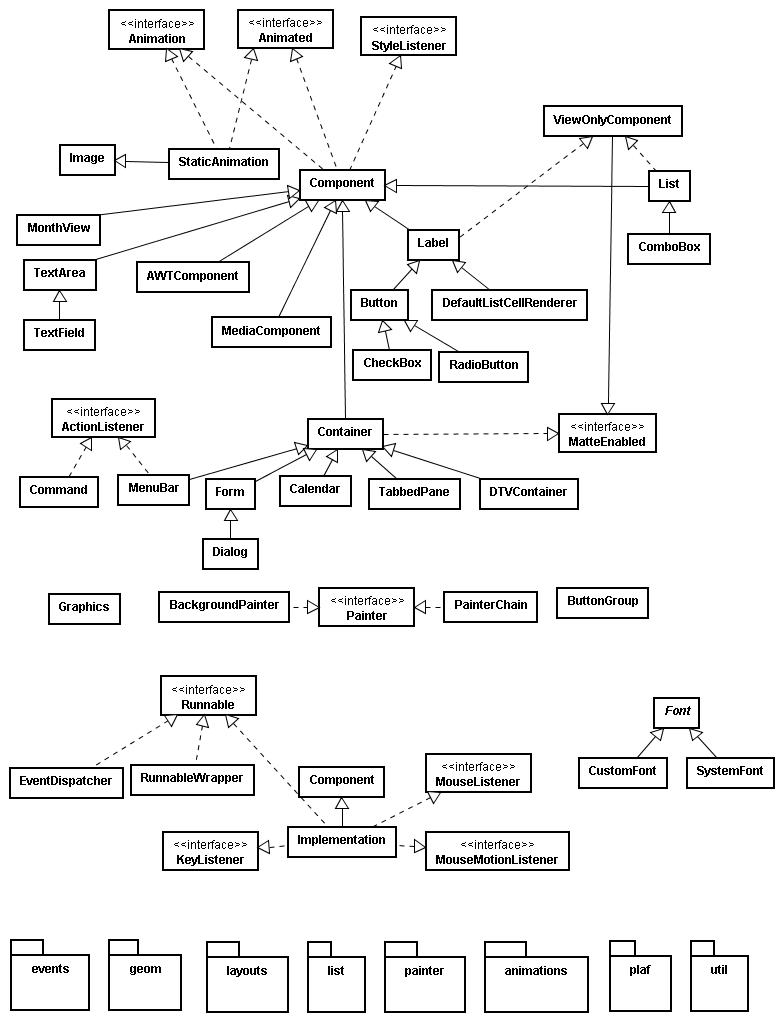
|
Java DTV API 1.3 18-Nov-2009 |
||||||||
| PREV PACKAGE NEXT PACKAGE | FRAMES NO FRAMES | ||||||||
See:
Description
| Interface Summary | |
|---|---|
| Painter | Painter can be used to draw on components backgrounds. |
| Class Summary | |
|---|---|
| AWTComponent | This class extends the Component class as a special
variant, which delegates painting to a wrapped java.awt.Component. |
| Button | Button is the base class for several UI widgets allowing clickability. |
| ButtonGroup | This class is used to create a multiple-exclusion scope for a set of RadioButtons. |
| Calendar | Date widget for selecting a date/time value. |
| CheckBox | Checkbox is a button that can be selected or deselected, and which displays its state to the user. |
| ComboBox | A combo box is a list that allows only one selection at a time, when a user clicks the combo box a popup button with the full list of elements allows the selection of a single element. |
| Command | The action placed on the soft buttons and in the Menu on devices, similar to the MIDP command abstraction and Swing's Actions. |
| Component | Base class for all the widgets in the toolkit using the composite pattern in a similar way to the AWT Container/Component relationship. |
| Container | A composite pattern with Component, allows nesting and arranging multiple
components using a pluggable layout manager architecture. |
| Dialog | A dialog is a form that occupies a part of the screen and appears as a modal entity to the developer. |
| Font | A simple abstraction of platform fonts and library fonts that enables the library to use more elaborate fonts unsupported by a specific device. |
| Form | Top level component that serves as the top-most visible entity in the UI (directly
embedded into the DTVContainer, this Container handles
the menus and title while placing content between them. |
| Graphics | Abstracts the underlying platform graphics context thus allowing us to achieve portability between MIDP devices and CDC devices. |
| Image | Abstracts the underlying platform images allowing us to treat them as a uniform object. |
| Label | Allows displaying labels and images with different alignment options, this class is a base class for several components allowing them to declare alignment/icon look in a similar way. |
| List | A set of elements that is rendered using a ListCellRenderer
and are extracted via the ListModel. |
| MediaComponent | A component allowing us to embed and control rich media content. |
| RadioButton | RadioButton is a Button that maintains a selection state exclusively
within a specific ButtonGroup. |
| StaticAnimation | An Image capable of animation. |
| TabbedPane | A component that lets the user switch between a group of components by clicking on a tab with a given title and/or icon. |
| TextArea | An optionally multi-line editable region that can display text and allow a user to edit it. |
| TextField | Allows in place editing using a lightweight API without necessarily moving to the external native text box. |
Main widget package containing the component/container "composite" similar
both in terminology and design to Swing/AWT. Unlike Swing/AWT a full windowing
system is not applicable in this case and forms are placed using a
DTVContainer passed into Plane
and Screen abstractions.
Components are placed in a container with layout managers that are used to detemine
component positioning Layout, containers can be nested
deeply in a similar way to Swing/AWT. All components are lightweight and drawn by
the UIManager which allows us to theme everything using
styles. It also alows elaborate UI customizability by deriving LookAndFeel
and overriding specific methods for drawing/sizing components.

|
Java DTV API 1.3 18-Nov-2009 |
||||||||
| PREV PACKAGE NEXT PACKAGE | FRAMES NO FRAMES | ||||||||